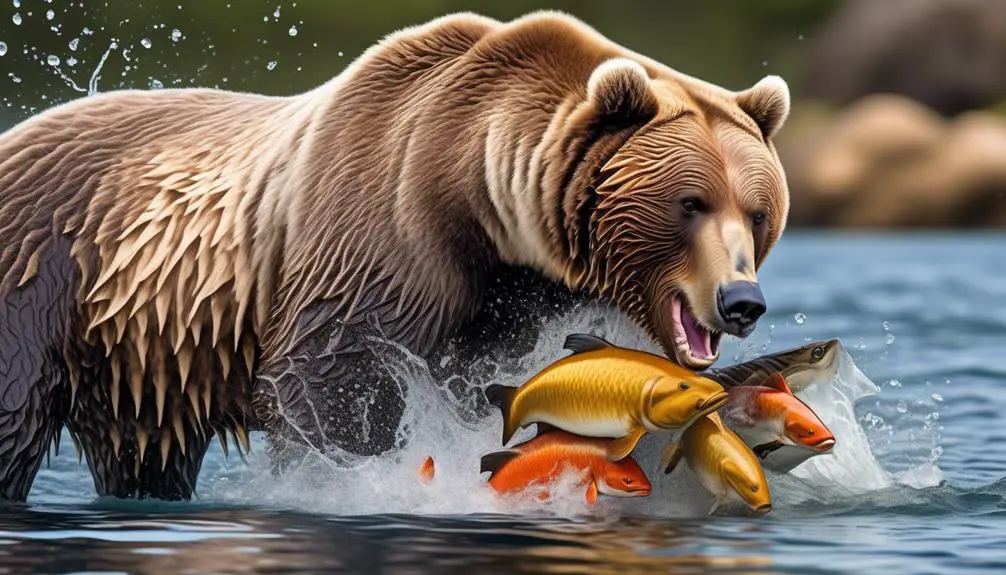Did you know that there are numerous animals out there who rely on fish as a crucial part of their diet? From the depths of the ocean to the lush forests, these creatures have developed fascinating adaptations to catch and consume fish.
But it’s not just the well-known predators like sharks and whales that feast on fish; there are also unexpected hunters like bears, jaguars, and even flamingoes.
In this article, we will take a closer look at some of these incredible fish-eating animals, revealing their unique strategies and showcasing captivating pictures that will leave you in awe.
Get ready to dive into the intriguing world of these aquatic hunters and discover the extraordinary ways they hunt down their slippery prey.
Alligators
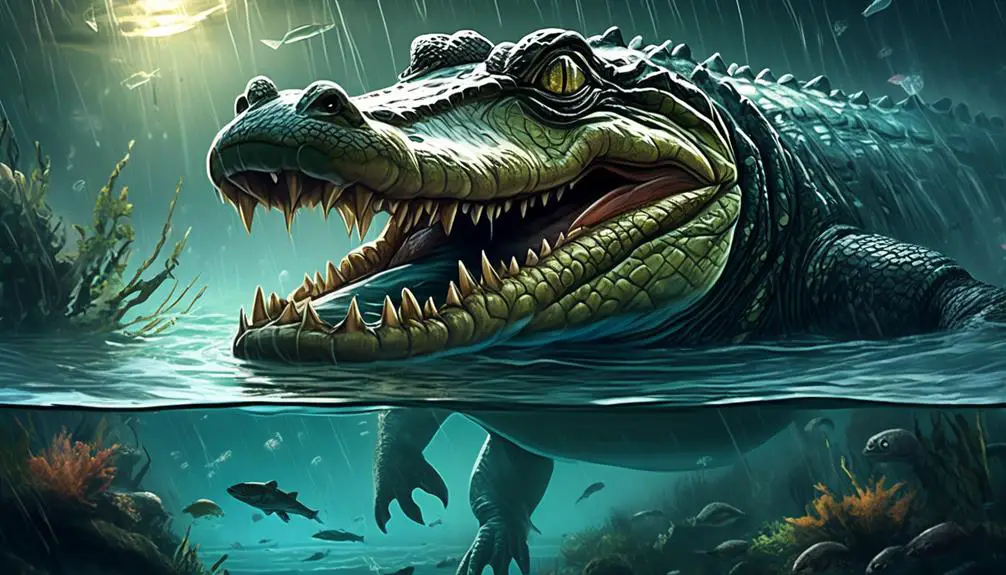
Alligators, as opportunistic feeders, actively consume a variety of edible animals, including fish. They’re powerful predators with a strong jaw and sharp teeth, perfectly adapted for capturing and consuming their prey. Fish make up a significant portion of an alligator’s diet, especially in their aquatic habitats.
These reptiles have a keen sense of smell that allows them to detect the presence of fish in the water. Once located, alligators stealthily approach their prey, using their muscular bodies and powerful tails to propel themselves through the water.
With a sudden burst of speed, they lunge forward, clamping their jaws around the fish, and securing it with their sharp teeth. Alligators are capable of consuming fish whole, thanks to their flexible jaws and expandable stomachs. They can also tear apart larger fish into smaller, more manageable pieces.
The consumption of fish provides alligators with essential nutrients, including protein and fat, necessary for their growth and survival. It’s fascinating to observe these remarkable creatures in action as they actively pursue and consume their aquatic prey.
Whales
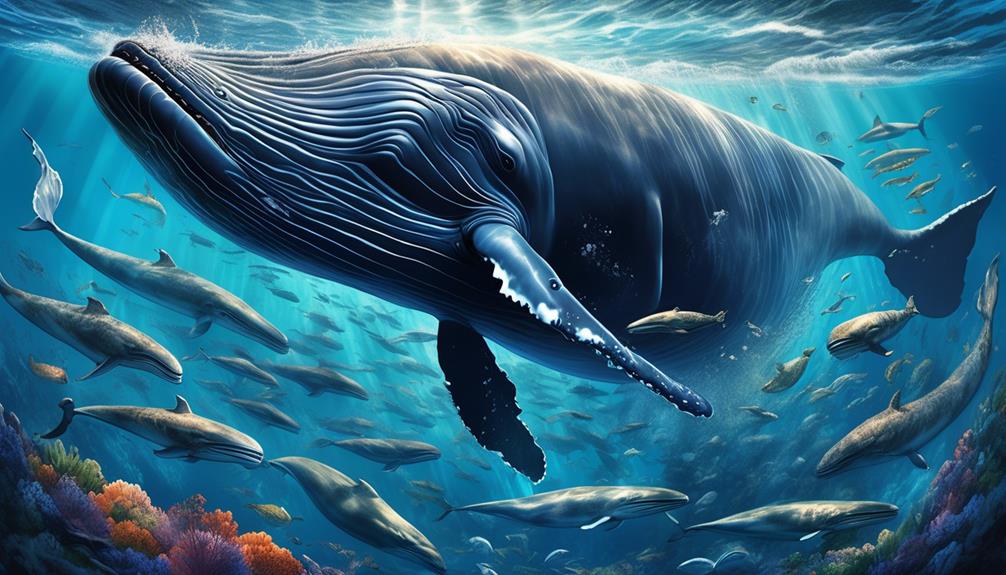
Whales, as magnificent marine mammals, have diverse diets and feeding techniques when it comes to consuming fish. There are two main types of whales: toothed whales and baleen whales.
Toothed whales, such as dolphins and orcas, have sharp teeth that enable them to catch and consume fish directly.
On the other hand, baleen whales, like humpback and blue whales, use baleen plates in their mouths to filter large amounts of water, capturing small fish and other prey in the process.
These different feeding strategies allow whales to efficiently obtain the fish they need for sustenance.
Whale Diet Types
Have you ever wondered about the various types of diets that whales follow in their natural habitats?
Whales have diverse diet types, depending on their species and location. Toothed whales, such as orcas and sperm whales, are known as active hunters. They primarily feed on fish, including species like salmon, herring, and mackerel. These whales use their sharp teeth to catch and consume their prey.
On the other hand, baleen whales, like humpbacks and blue whales, are filter feeders. They consume enormous amounts of tiny organisms, including krill and small fish, by straining them through baleen plates in their mouths. These whales open their mouths wide and swim through swarms of prey, filtering out the water and retaining the food.
The types of fish whales eat ultimately depend on their species, location, and feeding strategies.
Fish Consumption Patterns
Whale species exhibit distinct patterns of fish consumption as part of their dietary habits.
Toothed whales, such as orcas and dolphins, are active hunters that rely on their sharp teeth to catch and consume fish. They use echolocation to locate their prey and work together in groups to corral fish into tight clusters for easier capture.
Baleen whales, on the other hand, have a unique feeding strategy. They possess baleen plates in their mouths, which act as a filter to trap small fish and plankton while allowing water to pass through. These whales swim with their mouths open, engulfing large volumes of water, and then use their tongue to push out the water, leaving behind the fish that they consume.
This distinct pattern of fish consumption allows different whale species to thrive in their respective marine environments.
Whale Feeding Techniques
To understand the feeding techniques of whales, it’s important to delve into their unique adaptations and strategies for capturing and consuming fish. Whales have evolved various feeding techniques based on their specific species and habitat.
Toothed whales, such as dolphins and killer whales, use echolocation to locate and target their prey. They emit sound waves that bounce off objects in the water, allowing them to determine the location and size of fish.
Baleen whales, on the other hand, possess baleen plates in their mouths that act as filters. These whales gulp large volumes of water, trapping fish and other small organisms in their baleen, and then expel the water, leaving behind the prey to be consumed.
Some baleen whales also engage in lunge feeding, where they accelerate towards a school of fish with their mouths wide open, engulfing large quantities of fish in a single gulp.
These feeding techniques allow whales to efficiently capture and consume fish as an essential part of their diet.
Dolphins

Dolphins, highly intelligent marine mammals, possess remarkable echolocation abilities that aid in their hunting behavior. Using sound waves, dolphins can locate fish with precision, even in dark or murky waters.
In addition to their echolocation skills, dolphins exhibit complex social behavior, often hunting in groups called pods.
Their diverse diet includes a variety of fish species, such as herring, mackerel, and sardines, making them versatile predators in the ocean ecosystem.
Echolocation Abilities
Echolocation, a remarkable sensory ability possessed by certain marine mammals, enables you to navigate and locate objects underwater using sound waves.
Dolphins, in particular, are known for their exceptional echolocation abilities. They emit a series of clicks and listen for the echoes to determine the location, size, and shape of objects in their environment.
By analyzing the returning echoes, dolphins can create a detailed mental map of their surroundings, even in murky or dark waters. This ability allows them to locate fish, navigate through complex underwater environments, and communicate with other dolphins.
Dolphins’ echolocation skills are so precise that they can detect objects as small as a ping pong ball from a distance of 60 feet.
This highly-developed sense is crucial for their survival and success as predators in the ocean.
Social Behavior
With their highly-developed echolocation abilities allowing them to navigate and locate objects underwater, dolphins also exhibit complex social behavior within their pods.
Dolphins are known for their strong social bonds and live in groups called pods, which can consist of a few individuals to hundreds. These pods have a hierarchical structure, with dominant individuals leading the group.
Communication plays a crucial role in dolphin social behavior, with dolphins using a variety of vocalizations, body movements, and behaviors to communicate with one another.
They engage in cooperative hunting, where they work together to corral and capture fish. Dolphins also display affiliative behaviors, such as touching, rubbing, and leaping, which strengthen social bonds within the pod.
These social behaviors are important for maintaining group cohesion and cooperation, ensuring the survival and success of the pod as a whole.
Diverse Diet
A diverse diet is essential for dolphins, as they rely on a wide range of prey species to meet their nutritional needs. While dolphins are known as ‘piscivores,’ their diet isn’t limited to fish alone. They also consume squid, crustaceans, and even small marine mammals.
Dolphins have sharp teeth and a streamlined body that enables them to catch and consume their prey efficiently. They’re highly skilled hunters, using echolocation to locate and capture their food. Dolphins have been observed using cooperative hunting techniques, where they work together to corral fish into tight groups for easier capture.
This diverse diet ensures that dolphins receive the necessary nutrients, such as protein and fats, to maintain their energy levels and overall health.
Sharks
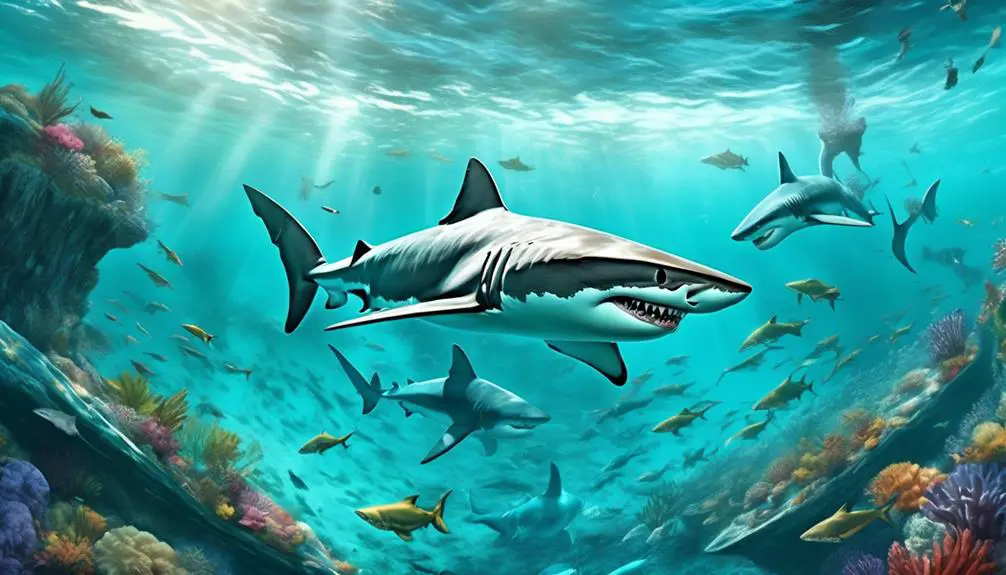
Sharks, as apex predators in the ocean, play a crucial role in the ecosystem by preying on various species of fish. They are highly adapted hunters with streamlined bodies, powerful jaws, and rows of sharp teeth. Here is a table highlighting some fascinating shark species and the types of fish they consume:
| Shark Species | Types of Fish Preyed On |
|---|---|
| Great White Shark | Tuna, Mackerel, Salmon |
| Tiger Shark | Bony Fish, Rays, Sea Turtles |
| Hammerhead Shark | Stingrays, Bonito, Sardines |
| Bull Shark | Catfish, Tarpon, Barracuda |
| Whale Shark | Plankton, Small Fish |
The Great White Shark, known for its immense size and power, preys on fast-swimming fish like tuna and mackerel. The Tiger Shark, with its broad diet, consumes bony fish, rays, and even sea turtles. Hammerhead Sharks have uniquely shaped heads that aid in hunting stingrays, bonito, and sardines. Bull Sharks, found in both freshwater and saltwater environments, feed on catfish, tarpon, and barracuda. Lastly, the gentle giant, the Whale Shark, filters plankton and small fish using its wide mouth.
These awe-inspiring creatures showcase the diversity of fish species that sharks prey on, illustrating their vital role in maintaining the balance of marine ecosystems. Understanding the diets of sharks not only deepens our knowledge of these fascinating predators but also emphasizes the significance of conserving their habitats to ensure the survival of these magnificent hunters.
Squids
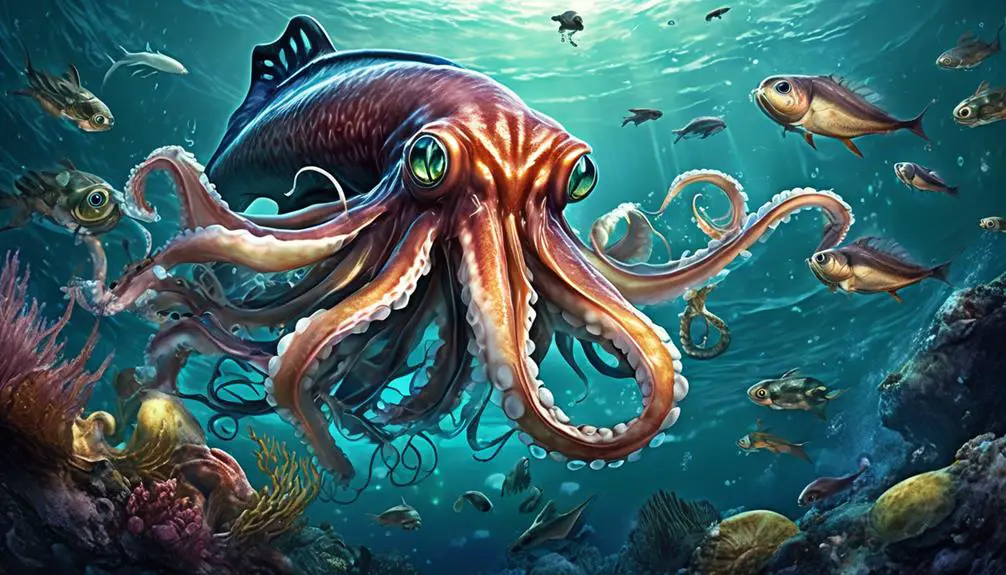
Squids, translucent marine cephalopods, have a diverse and carnivorous diet. With their large appetites, they consume a significant amount of food, including small fish like cuttlefish and lantern fish.
They’re also capable of hunting and devouring larger fish such as codfish, hake, mackerel, and herring. As dangerous marine predators, squids rely on their size advantage to capture and consume fish in their watery habitats.
Squid Diet and Behavior
Squids, fascinating marine creatures known for their translucent bodies and remarkable hunting abilities, have a diverse diet consisting of crustaceans and various types of fish. These cephalopods are skilled predators that employ different feeding strategies to catch their prey.
Squids have a large appetite and consume a significant amount of food. They primarily feed on small fish like cuttlefish and lantern fish. However, larger species of squids, such as giant squids, are capable of devouring larger fish like codfish, hake, mackerel, and herring.
Squids are dangerous marine predators that hunt fish based on their size. They use their sharp beaks and tentacles to subdue and capture their prey, making them formidable hunters in the oceanic food chain.
Giant Squids and Prey
As we shift our focus to the intriguing world of giant squids and their prey, it is important to understand how these formidable creatures navigate the depths of the ocean in search of sustenance. Giant squids, with their elongated bodies and powerful tentacles, are skilled hunters that feed on a variety of fish species. They have a unique ability to detect their prey using a combination of keen eyesight and a highly developed sense of smell. Once a giant squid spots its target, it swiftly moves towards it, capturing the fish with its strong tentacles and bringing it towards its beak-like mouth. To give you a better idea of the types of fish that giant squids commonly consume, here is a table showcasing some of their preferred prey:
| Fish Species | Size Range (in cm) | Habitat |
|---|---|---|
| Codfish | 30-120 | Cold waters |
| Hake | 20-90 | Temperate and cold waters |
| Mackerel | 20-50 | Coastal and open waters |
| Herring | 15-30 | Coastal and open waters |
These fish species provide a rich source of nutrients for giant squids, helping them sustain their massive bodies and active lifestyles in the deep sea.
Squids as Marine Predators
With their exceptional hunting abilities and voracious appetites, squids emerge as formidable marine predators in the vast depths of the ocean. These translucent cephalopods are crustacean and fish-eaters, consuming a significant amount of food to sustain their large appetites.
While smaller squids primarily feed on small fish like cuttlefish and lantern fish, giant squids are capable of targeting larger fish such as codfish, hake, mackerel, and herring. Squids are dangerous predators that select their prey based on size, using their agile bodies and tentacles to capture and immobilize their targets. With their sharp beaks and toothed suckers, they can tear apart their catch with ease.
Squids play a crucial role in the marine food chain, maintaining balance and contributing to the overall diversity of the ocean ecosystem.
Apes

Apes, including great apes like gorillas, chimpanzees, and orangutans, are omnivorous creatures that require a protein-rich diet to support their muscle mass. While their diet primarily consists of fruits, leaves, and flowers, apes also regularly hunt and consume fish. Fish provides an important source of protein for these primates, aiding in the growth and maintenance of their muscle tissue.
To give you a better understanding of the fish consumption by apes, here is a table showcasing the different fish species that are part of their diet:
| Ape Species | Fish Consumed | Locations |
|---|---|---|
| Gorillas | Catfish, tilapia, small river fish | Rainforests of Central Africa |
| Chimpanzees | Small river fish, freshwater crabs | Forests of Central and West Africa |
| Orangutans | Small fish, including freshwater fish | Rainforests of Borneo and Sumatra |
As you can see, fish consumption varies among ape species and their respective habitats. While gorillas mainly consume catfish and tilapia, chimpanzees have a preference for small river fish and freshwater crabs. Orangutans, on the other hand, consume a variety of small fish, including freshwater species.
It is interesting to note that orangutans may even fish in water bodies due to the scarcity of their usual food sources. This behavior demonstrates the adaptability and resourcefulness of these intelligent creatures.
Turtles

Continuing our exploration of animals that consume fish, let’s now turn our attention to the fascinating world of turtles and their dietary habits.
Turtles are voracious eaters and exhibit a diverse range of feeding strategies. While some turtle species are herbivorous, others are omnivorous or carnivorous, including fish in their diet. Aquatic and freshwater turtles, in particular, are known to consume fish as a regular part of their feeding routine.
The diet of turtles largely depends on the fish found in their respective water bodies. Hatchlings, being smaller and more agile, are quicker to consume small fish, while adult turtles are less likely to prey on fish. Fish consumption by turtles is influenced by factors such as the availability of suitable prey, water temperature, and the turtle’s size and age.
Turtles are equipped with specialized adaptations to catch and consume fish. Their strong jaws and sharp beaks allow them to capture and crush their prey effectively. Some turtle species, like the alligator snapping turtle, possess a lure on their tongue that resembles a small worm, attracting fish towards their waiting mouths.
Bald Eagles

Bald Eagles, renowned as ‘piscivores’, exhibit exceptional hunting skills as they dive from great heights to capture and consume fish as a regular part of their diet. These majestic birds have sharp eyesight, allowing them to detect fish from miles above. Once a potential prey is spotted, the eagle swiftly descends towards the water’s surface, using its powerful wings to navigate with precision.
With their strong and curved talons, they snatch the fish from the water, gripping it firmly. The eagle quickly dispatches the fish using its sharp beak, tearing into its flesh to consume it. Although bald eagles are known for their preference for fish, they’re opportunistic feeders and will also consume other small mammals and birds when available.
However, fish make up a significant portion of their diet, with species like salmon and trout being favored. This diet provides the necessary protein and nutrients for their survival and sustains their impressive size and strength. The consumption of fish isn’t only a regular part of the bald eagle’s diet but also a testament to their exceptional hunting abilities.
Bears
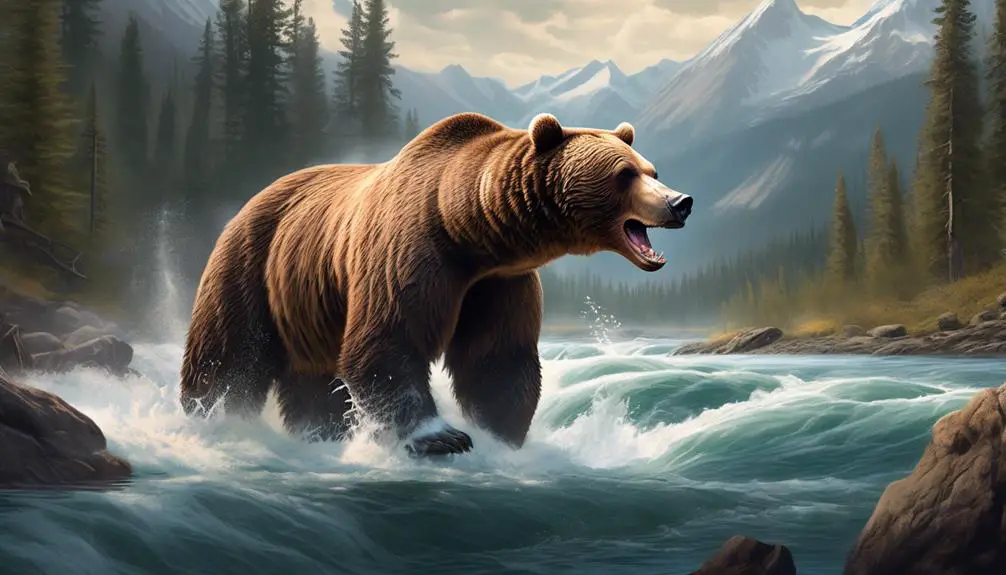
Moving on from the discussion on bald eagles, let’s now explore the fascinating dietary habits of bears.
Bears are omnivores and excellent hunters, capable of catching and consuming fish. Some bear species, such as grizzly bears and polar bears, rely heavily on fish, especially during salmon runs. Fish serves as a vital source of protein for bears, helping them replenish the body fat lost during hibernation.
Bears employ their sharp claws and strong jaws to catch and consume fish. They may wade into rivers and streams, patiently waiting for fish to swim by before swiftly striking with their claws. Bears also exhibit remarkable agility when it comes to catching fish, often displaying quick reflexes and coordination.
The consumption of fish by bears not only provides them with essential nutrients but also contributes to their overall survival. Fish consumption plays a significant role in maintaining their energy levels and supporting their growth and development.
Bears are remarkable creatures, showcasing their adaptability and resourcefulness in their dietary choices. Their ability to catch and consume fish demonstrates their skill as hunters and their capacity to thrive in various environments.
Jaguars
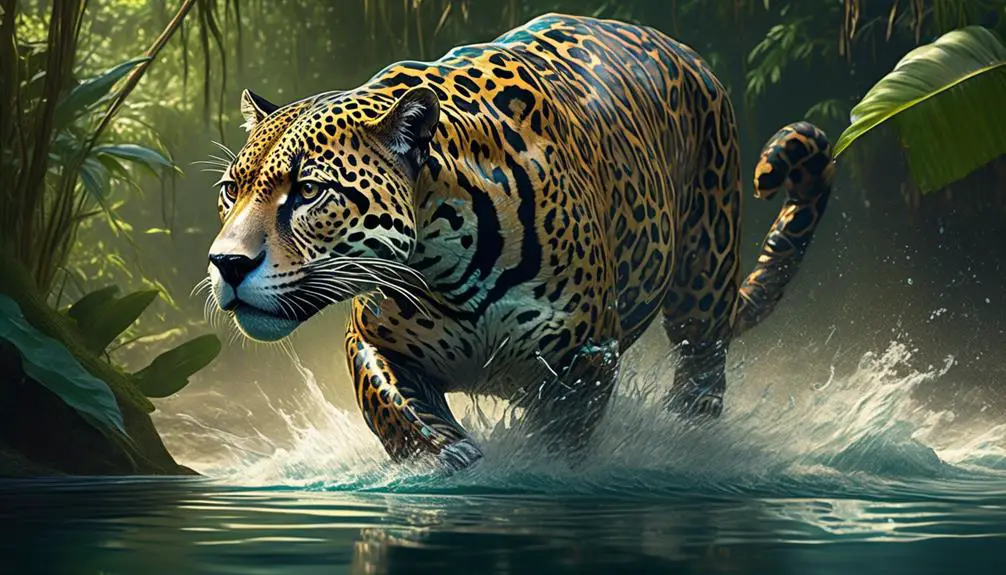
Jaguars, known for their prowess as carnivores and apex predators, exhibit a unique hunting behavior by luring fish using their tail as bait. This remarkable strategy allows them to catch fish with precision and efficiency. Jaguars are exceptional swimmers and are often found near bodies of water where they patiently wait for the perfect moment to strike.
To help visualize this fascinating hunting technique, let’s take a look at the following table:
| Behavior | Description |
|---|---|
| Tail as Bait | Jaguars use their long, muscular tails to mimic the movement of a fish. They dangle their tails above the water’s surface, creating ripples and splashes that attract nearby fish. This baiting technique is highly effective in enticing fish to approach, unaware of the danger lurking beneath the surface. |
| Ambush Attack | Once the fish are within striking distance, the jaguar swiftly pounces, using its powerful jaws to capture the unsuspecting prey. With sharp claws and paws, the jaguar secures its catch, ensuring it doesn’t escape. This agile and precise hunting behavior showcases the jaguar’s exceptional hunting skills and adaptability. |
| Varied Diet | While fish consumption by jaguars may vary depending on the availability of other prey, it is an important part of their diet. Jaguars are opportunistic hunters and will consume a wide range of prey, including fish, mammals, birds, and reptiles. Their ability to adapt to different food sources is an essential survival trait. |
Jaguars’ ability to lure and capture fish with their tails is a testament to their adaptability and resourcefulness as predators. This unique hunting behavior sets them apart from other carnivores and showcases their remarkable skills in the animal kingdom.
Flamingoes

Flamingoes, graceful and elegant birds known for their vibrant plumage, are specialized filter feeders that consume small fish and other aquatic organisms. These fascinating creatures have adapted their physical features to effectively capture their prey.
Flamingoes have long, slender necks that allow them to reach deep into the water, while their uniquely shaped bills are designed for filtering food. Their bills contain specialized structures called lamellae, which act like tiny sieves. As the flamingo sweeps its bill through the water, it traps small fish and other microscopic organisms in these lamellae.
Flamingoes are often found in large flocks, wading in shallow waters where their prey is abundant. They use their webbed feet to stir up the mud and sediment at the bottom, creating a cloud of particles. This method helps to dislodge hidden fish and makes them easier to catch. Once the fish are trapped in their bills, the flamingoes use their tongues to push the water out, allowing them to swallow their prey.
The diet of flamingoes varies depending on the availability of suitable feeding grounds. While small fish make up a significant portion of their diet, they also consume shrimp, mollusks, and other invertebrates. The vibrant pink color of a flamingo’s feathers is due to the pigments found in the small crustaceans they consume.
Wolves

Wolves, formidable carnivores and skilled hunters, have been known to incorporate fish into their diet as an additional food source, particularly in shallow water bodies and tidal pools. While wolves primarily rely on mammals for sustenance, their opportunistic nature allows them to adapt and exploit available resources, including fish. This behavior is observed in regions where wolves have access to water bodies, such as rivers, lakes, and coastlines.
When wolves encounter fish-rich environments, they take advantage of this abundant food source. They employ their keen senses, including their acute sense of smell, to detect fish in the water. Wolves then utilize their agility and coordination to stalk, chase, and capture the fish. They may employ strategies such as ambushing from the shoreline or wading into shallow waters to intercept swimming fish.
The inclusion of fish in a wolf’s diet provides them with additional nutrients, including essential fatty acids, proteins, and minerals. Fish consumption may occur more frequently during specific seasons, such as spawning events when fish are more accessible and concentrated in certain areas.
It is noteworthy that fish consumption by wolves may vary depending on the region and the availability of other prey. Wolves are adaptable predators, and their dietary composition may fluctuate based on environmental factors and the availability of alternative food sources. Nonetheless, their ability to incorporate fish into their diet highlights their versatility as hunters and their capacity to exploit various food resources in their ecosystems.

Erzsebet Frey (Eli Frey) is an ecologist and online entrepreneur with a Master of Science in Ecology from the University of Belgrade. Originally from Serbia, she has lived in Sri Lanka since 2017. Eli has worked internationally in countries like Oman, Brazil, Germany, and Sri Lanka. In 2018, she expanded into SEO and blogging, completing courses from UC Davis and Edinburgh. Eli has founded multiple websites focused on biology, ecology, environmental science, sustainable and simple living, and outdoor activities. She enjoys creating nature and simple living videos on YouTube and participates in speleology, diving, and hiking.

